 Open Access
Open Access
ARTICLE
A Deep Reinforcement Learning-Based Technique for Optimal Power Allocation in Multiple Access Communications
1 Department of Industrial Engineering, College of Engineering, University of Houston, Houston, TX, 77204, USA
2 Department of Computer Science, Iowa State University, Ames, Iowa, USA
3 ETSI de Telecomunicación, Universidad Politécnica de Madrid, Madrid, Spain
4 Faculty of School of Plant and Environmental Sciences, Virginia Polytechnic Institute and State University, Blacksburg, Virginia, 24060, USA
* Corresponding Author: Diego Martín. Email:
Intelligent Automation & Soft Computing 2024, 39(1), 93-108. https://doi.org/10.32604/iasc.2024.042693
Received 08 June 2023; Accepted 24 January 2024; Issue published 29 March 2024
Abstract
For many years, researchers have explored power allocation (PA) algorithms driven by models in wireless networks where multiple-user communications with interference are present. Nowadays, data-driven machine learning methods have become quite popular in analyzing wireless communication systems, which among them deep reinforcement learning (DRL) has a significant role in solving optimization issues under certain constraints. To this purpose, in this paper, we investigate the PA problem in a -user multiple access channels (MAC), where transmitters (e.g., mobile users) aim to send an independent message to a common receiver (e.g., base station) through wireless channels. To this end, we first train the deep Q network (DQN) with a deep Q learning (DQL) algorithm over the simulation environment, utilizing offline learning. Then, the DQN will be used with the real data in the online training method for the PA issue by maximizing the sumrate subjected to the source power. Finally, the simulation results indicate that our proposed DQN method provides better performance in terms of the sumrate compared with the available DQL training approaches such as fractional programming (FP) and weighted minimum mean squared error (WMMSE). Additionally, by considering different user densities, we show that our proposed DQN outperforms benchmark algorithms, thereby, a good generalization ability is verified over wireless multi-user communication systems.Keywords
Nowadays, due to the explosive demand for using wireless applications with higher data rates by users, the next generation of wireless communication networks (6G) should be designed to guarantee successful data transmission [1–4]. On the other hand, in multi-user wireless communication systems such as multiple access channels (MAC), where users send their independent data to the common receiver, more capacity and spectral efficiency are required than the single-user point-to-point (P2P) communications. One promising approach to meet these challenges is to more effectively allocate network resources with interference management. Generally speaking, power allocation (PA) is an effective technique that can improve the performance of wireless networks by delivering the source information to the destination efficiently. In addition, by allocating the appropriate source power to each user, the quality of service (QoS) and fairness for all mobile users, especially the edge users, in multiple access communications can be guaranteed. However, the lack of flexible guidelines for providing fair resource allocation to users and significant interference caused by the unplanned deployment of other nodes are momentous issues that should be modified to make wireless multi-user networks work perfectly. To this end, in this paper, we investigate the PA problem by exploiting machine learning (ML) methods to maximize the sumrate of wireless multiple access communications [5,6]. However, this optimization problem is non-convex and NP-hard [7–10] PA so it cannot be solved efficiently [11–14]. NP-hard problems are difficult to solve efficiently, and finding an optimal solution typically requires exploring a large number of possibilities. While no known efficient algorithm exists for solving NP-hard problems in the general case, various approximation algorithms and heuristics can be employed to find good solutions or approximate solutions within a reasonable amount of time [15–17].
In recent years, several algorithms have been proposed for the PA problem such as fractional programming (FP) and weighted minimum mean squared error (WMMSE) [18–21]. Although these methods have excellent performances in both theoretical analysis and numerical simulation, they are not appropriate enough for implementation in real wireless communication systems [22]. In other words, these algorithms highly depend on tractable mathematical models, and the computational complexities are too high, so they are not suitable for practical usage where the user distribution, propagation environment, geographical location of nodes, etc., are considered as main factors. Therefore, the need for novel approaches to the PA problem in practical wireless communications feels more than ever. In this regard, ML-based methods have been rapidly developed in wireless communications over the last few years. The ML-based algorithms are often model-free and can be efficiently used for optimization problems over feasible wireless communication scenarios. In addition, regarding the advancements of the graphic processing unit (GPU), the implementation and performance of them can be affordable and fast, which provides a better condition for network operators.
There are several branches of the ML method, where supervised learning and reinforcement learning (RL) are the most popular ones [23]. Within supervised learning, a deep neural network (DNN) undergoes training to approximate certain optimal or suboptimal objective algorithms. Nevertheless, the target algorithm is often inaccessible, and the effectiveness of the DNN is constrained by the supervisor [24–27]. Conversely, Reinforcement Learning (RL) has found extensive application in optimizing systems of unknown nature through interaction. The adaptable nature of RL makes it a versatile solution for models where the statistical features of the system undergo continuous changes. The most well-known RL algorithm is the Q learning approach which has been recently studied for the PA problem in [28–30]. The trained DNN with Q learning is known deep Q learning network (DQN), which is proposed to resolve the PA problem in the single-user P2P communication system [31,32]. However, to the best of the authors’ knowledge, the PA problem over wireless multi-user communication systems such as fading MAC has not been investigated by exploiting the DQN model. Generally speaking, MAC is a fundamental channel model for uplink communications from an information-theoretic perspective in multi-user wireless networks, which has recently attracted significant attention in performance analysis of emerging technologies for 6G wireless communications [33–37]. Thus, analyzing the PA problem under wireless
Given the efficiency of deep learning (DL)-based methods in optimization problems, many contributions have been carried out for analyzing wireless communication networks from various aspects by exploiting DL algorithms. In [4], the authors discussed several novel applications of DL in physical layer security, where they showed how their ideas can be extended to multi-user secure communication systems. They also introduced radio transformer networks (RTNs) as a flexible approach to integrating expert knowledge into the DL model. The PA problem for a downlink massive multiple-input multiple-output (MIMO) system by exploiting DL methods was studied in [43]. In this work, the authors trained a deep neural network to teach the relationship between user positions and optimal PA policies. Subsequently, they endeavored to anticipate PA profiles for a novel set of user positions. The findings indicated that the utilization of DL in MIMO systems can markedly enhance the trade-off between complexity and performance in PA, as opposed to conventional optimization-centric approaches. Due to the lack of celebrated algorithms like water-filling and max-min fairness for analyzing the PA problem in wireless type-machine communication (MTC), the authors in [44] introduced the learning centric power allocation (LCPA) method, offering a fresh perspective on radio resource allocation in a learning-driven scenario. This approach involves the use of an empirical classification error model supported by learning theory and an uncertainty sampling method that considers diverse distributions among users, the authors formulated the LCPA as a non-convex non-smooth optimization problem and they indicated that their proposed LCPA algorithms outperform traditional PA algorithms. In [45], the authors executed a dynamic PA scheme by applying model-free deep reinforcement learning (DRL), where each user can collect the channel state information (CSI) and quality of service (QoS) information from several nodes and adopt its own transmit power accordingly. With the goal of optimizing a utility function based on the weighted sum rate, the study utilized DQN to analyze both random variations and delays in CSI. The findings demonstrated that the suggested framework is particularly suitable for practical scenarios characterized by inaccuracies in the system model and non-negligible delays in CSI. The authors in [46] introduced a distributed reinforcement learning approach known as distributed power control using Q-learning (DPC-Q). This method was designed to manage interference generated by femtocells on users in downlink cellular networks. The authors explored two distinct approaches for DPC-Q, namely, independent and cognitive scenarios. By considering the heterogeneous cellular networks (HetNets), the authors in [47] employed a machine learning approach based on Q-learning to address the resource allocation challenge in intricate networks. They defined each base station as an agent, and in the context of multi-agent cellular networks, cooperative Q-learning was utilized as an effective method for resource management in such multi-agent network scenarios. The results in [47] illustrated that using the Q-learning approach can offer more than a four-fold increase in the number of supported femtocells compared with previous works. In [48], a strategy for optimizing energy consumption was introduced, employing techniques from DRL and transfer learning (TL). The authors incorporated an adaptive reward system to autonomously modify parameters within a reward function, aiming to strike a balance between users’ energy consumption and QoS requirements throughout the learning process. Furthermore, the authors in [49] focused on optimizing the ON/OFF strategy of small base stations by leveraging DQN to improve energy efficiency. Subsequently, they suggested a user-specific cell activation approach to address the challenge of allocating users with diverse requirements. Furthermore, in [50,51], a framework employing the DRL method was introduced to achieve the optimal solution for power-efficient resource allocation in beamforming problems.
Motivated by the above-mentioned observations, we investigate the PA problem in the multi-user communication system, exploiting the DQN model, where the simulation results show our proposed DQN model provides better performance as compared with benchmark algorithms. The main contributions of our work are summarized as follows:
• First, we propose a model-free two-step training structure, wherein the DQN is firstly trained offline with the DRL algorithm within simulated environments, and then the learned DQN is used for optimization problems in real multi-user communications through transfer learning.
• We also discuss the PA problem of exploiting deep Q learning (DQL). In this regard, we propose a DQN-enabled method and train it with the current sumrate as the reward function, lacking prospective rewards to aid the DQN in approaching the optimal solution.
• Finally, the suggested DQN is evaluated by distributed performance, and the results show that the average sumrate of DQN surpasses model-driven algorithms.
The remaining sections of this paper are structured as follows. Section 2 describes the system model and the PA problem in the considered wireless fading MAC. The details of our proposed DQN model are presented in Section 3. In Section 4, the efficiency of proposed DQN in comparison with benchmarks algorithms is illustrated by simulation results. Finally, Section 5 presents the conclusions and discussions.
Consider the wireless multiple-access communication system model depicted in Fig. 1, where transmitters
where
where
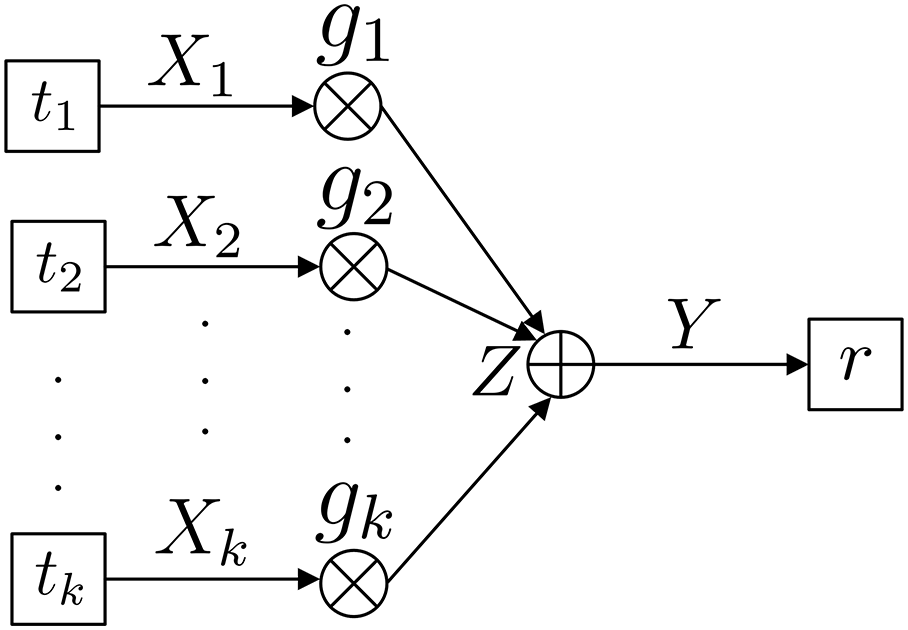
Figure 1: System model depicting the
The sumrate of the considered
We now formulate the optimization problem to maximize the generic sumrate objective function of the considered MAC under maximum power constraint as follows:
where
3 Problem Formulation and Proposed Solution
Q learning is a flexible model-free RL approach which widely used in dealing with the Markov decision process (MDP) problems [53]. Q learning is regarded as a function approximator with the value of Q, which depends on the state
where the discount factor
The primary objective of Q-learning is to identify the optimal behavior for agents operating in an unknown environment, with the goal of maximizing the Q function. To this end, the dynamic programming equation used to calculate a function approximator Q, commonly known as the Bellman equation, is employed to maximize Eq. (4). Thus, Bellman equation is defined as [54,55]:
where
The main novelty of Q learning is to utilize temporal-difference (TD) in order to approximate the Q function. To this end, the DQN is trained with the standard Q learning update of the parameters
where
3.2 Deep Reinforcement Learning
In most applications in which the current strategy has enduring impacts on the cumulative reward like playing video games, the DQN gains significant outputs and defeats players. However, for the PA problem in this scenario, the discount factor
Now, for our considered PA problem, we set
Since during the execution period the policy is deterministic, (12) can be expressed as:
which is an equivalent form of the maximization problem mentioned in (4). This result shows that the optimal solution for maximization problem in (4) is identical to that of (8), under the assumptions of
The optimal out for the maximization problem in (4) is just depends on the instantaneous wireless channel conditions, meaning that the ideal solution
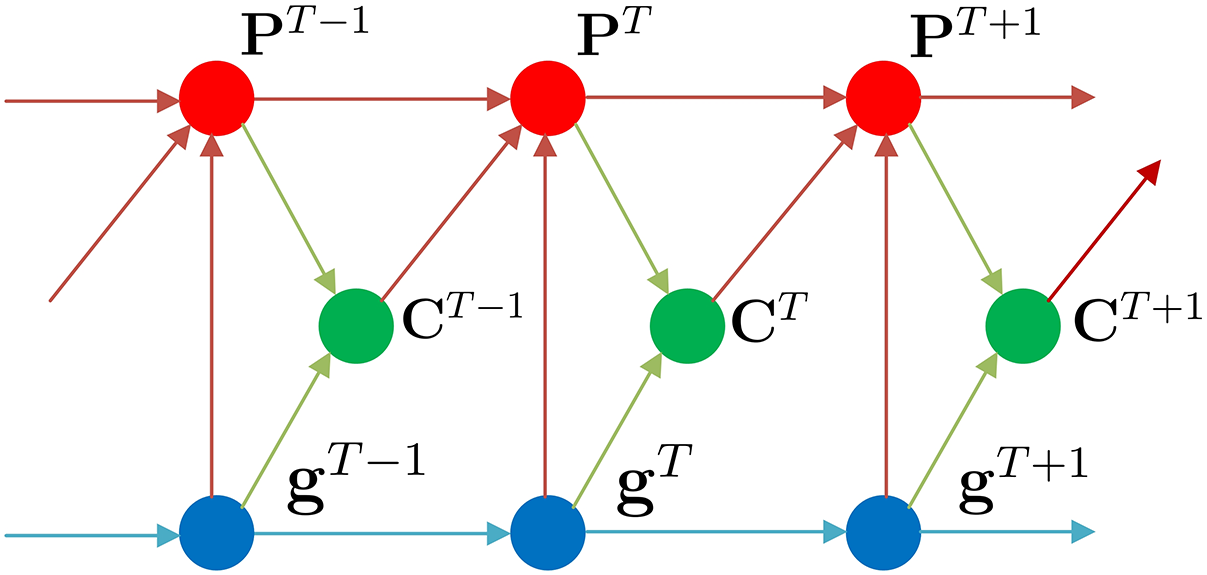
Figure 2: The DQN solution is achieved through CSI
By assuming
To alleviate the burden of online training caused by the inherent need for a substantial amount of data in the data-driven algorithm, in our proposed model, we first offline pre-train the DQN with the DRL algorithm over simulated wireless fading channels. Then, we dynamically set the learned DQN in real scenarios by exploiting the transfer learning. Due to the fact that the practical wireless fading channels are dynamic and also affected by the random factors in the propagation environment, the data-driven algorithm can be a promising approach to analyze such communication networks. Regarding the above-mentioned, we present our two-step framework in the following scenarios.
In the proposed wireless fading MAC, each transmitter-receiver link is considered as an agent; so, a multi-agent system model is analyzed. However, training the multi-agent model proves challenging as it demands an increased amount of learning data, training duration, and DNN parameters. Hence, we opt for centralized training and exclusively train a single agent, utilizing the experience replay memory from all agents. Consequently, we share the learned strategy of the considered agent over the distributed execution period. Therefore, we define the components of the replay memory for our designed DQN as follows:
Given that the full environment information is redundant, and the irrelevant elements should be eliminated, creating the accurate state of the agent is momentous. We assume that the agent includes the corresponding perfect instantaneous CSI in (2). Thus, the logarithmic normalized interferer set
We also normalize the channel amplitudes of interferes with that of the required link, and since the channel amplitudes are often modified by magnitude orders, we prefer the logarithmic format for them. To mitigate computational complexities and reduce input dimensionality, the elements in
The power considered in the maximization problem of (4) is a continuous variable which is only subjected to the maximum power limitation. Considering that the action space of the DQN needs to be finite, the available transmitting power is discretized into
where
In some previous works, the authors designed the reward function to improve the transmitting rate of the agent and also mitigate the interference influence, while this modeling is a suboptimal method to the target function of (4). In order to gain an optimal target for our considered problem, in this paper, we directly treat
In order to gain more insights into the DQL process for the considered PA problem over MAC, we provide Algorithm 1 which indicates the step-by-step description of this process.
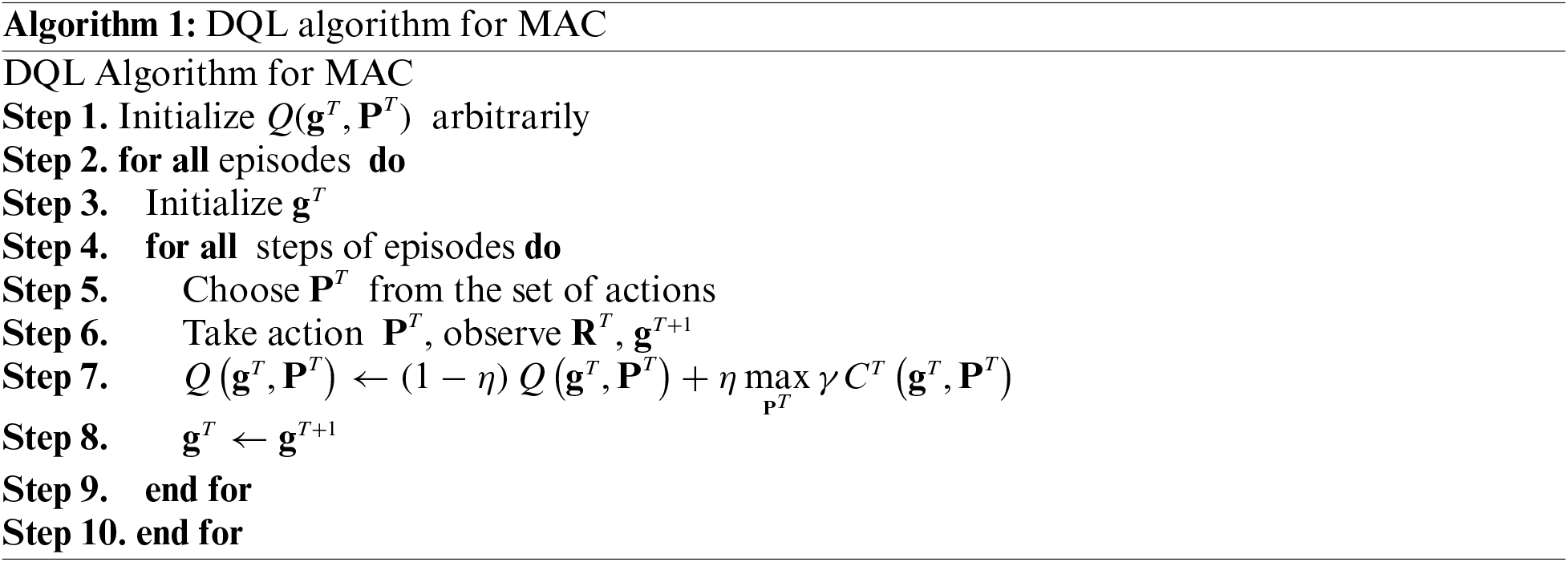
In this section, we showcase the simulation outcomes for the given PA problem under the
Specifically, we simulate the proposed model for
Utilizing pre-existing interaction data can be efficiently accomplished through offline RL, which operates in a fully off-policy RL setting. In this setup, the agent is trained using a static dataset of recorded experiences, without engaging in further interactions with the environment. Offline RL serves various purposes, including (i) pretraining an RL agent with existing data, (ii) empirically assessing RL algorithms based on their capacity to leverage a fixed dataset of interactions, and (iii) generating real-world impact. In online RL, actions with high rewards are chosen by an agent and then the corresponding agent receives corrective feedback. In contrast, since additional data cannot be collected in offline RL, it becomes essential to contemplate generalization using a fixed dataset. Therefore, utilizing techniques from supervised learning that employ an ensemble of models to enhance generalization, we employ random initialization as a straightforward method to extend the capabilities of DQN. The agents take actions randomly over the first

Here, we analyze the performance of the discount factor
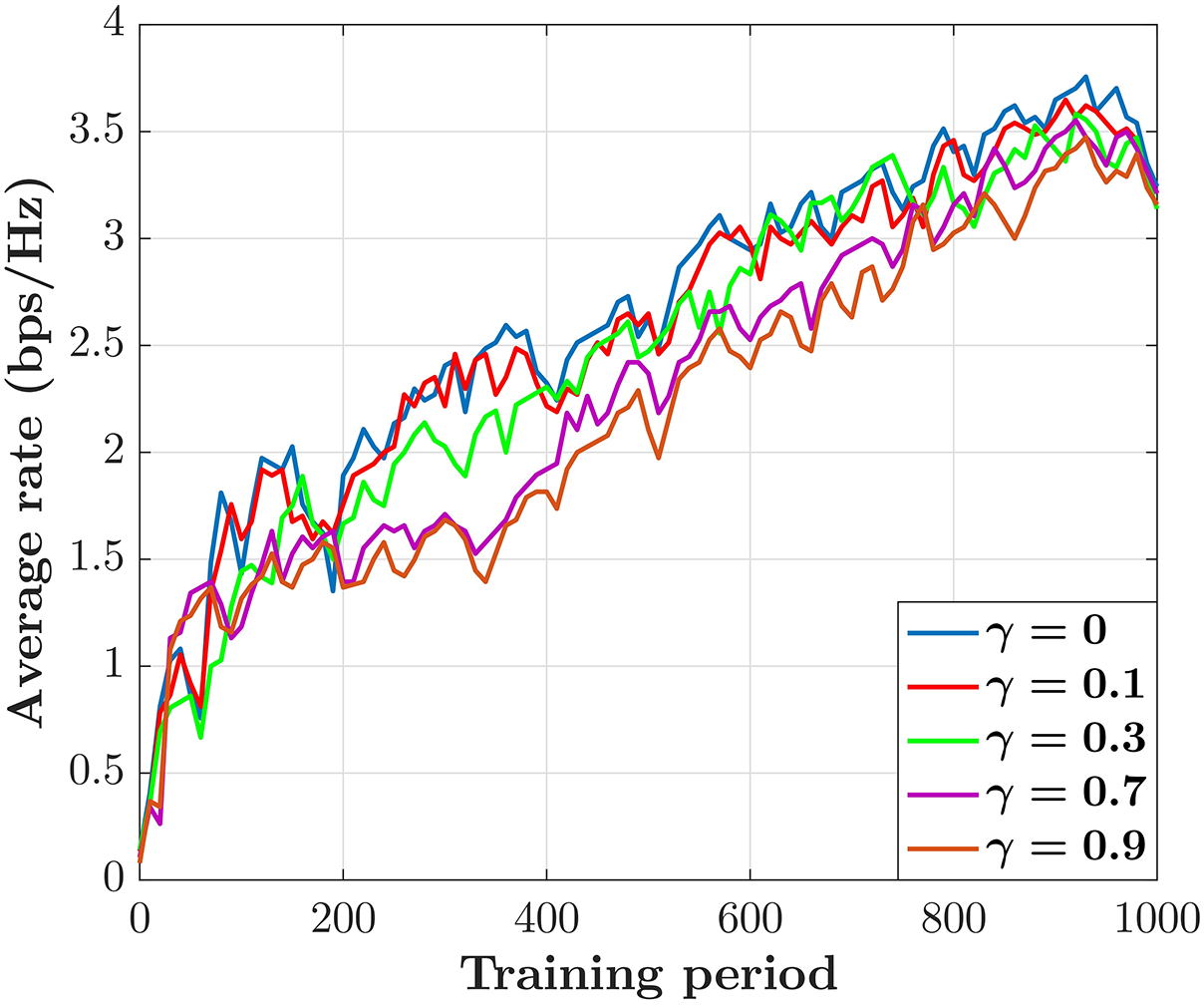
Figure 3: The average rate
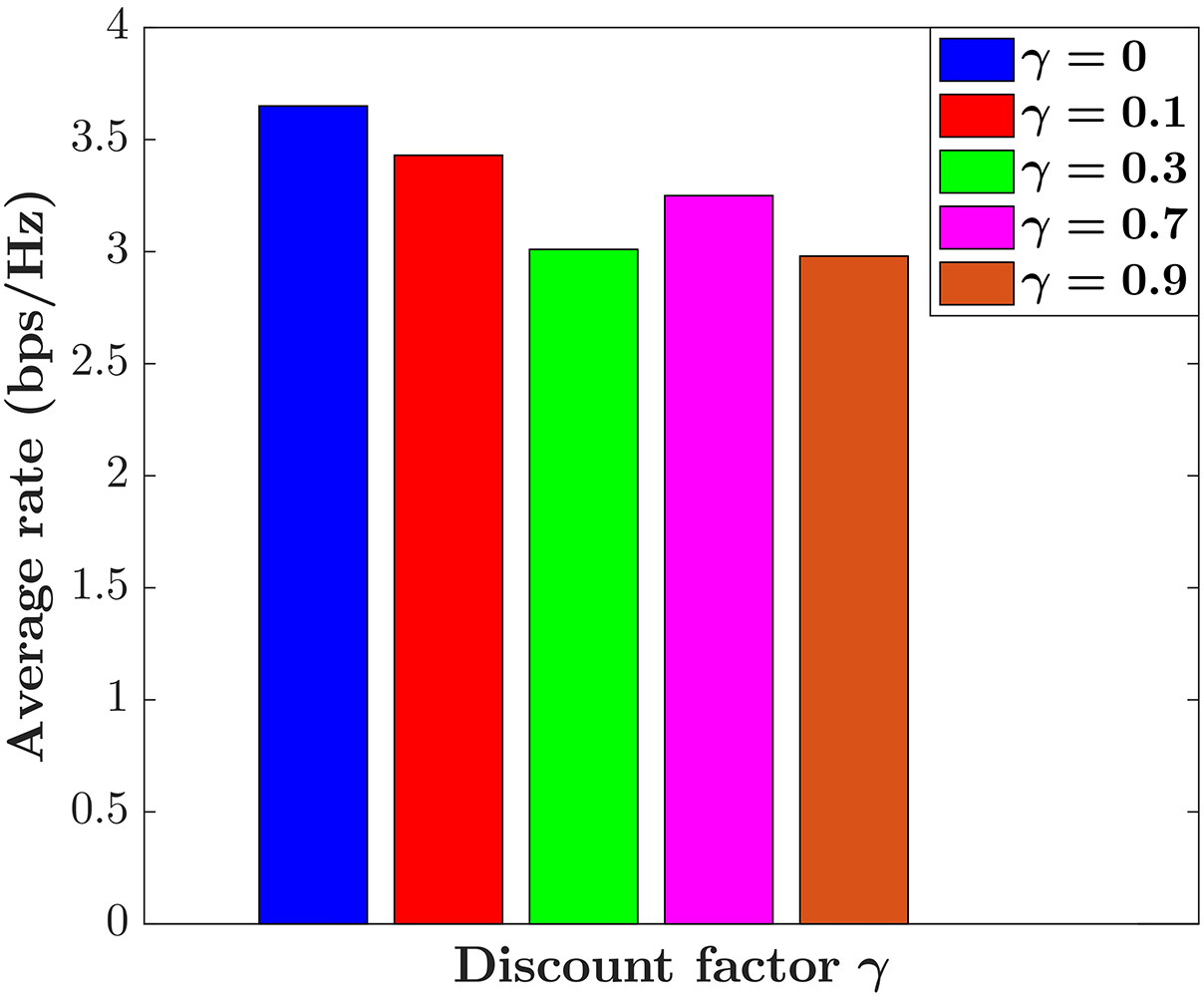
Figure 4: The average rate
In this subsection, we compare the trained DQN under
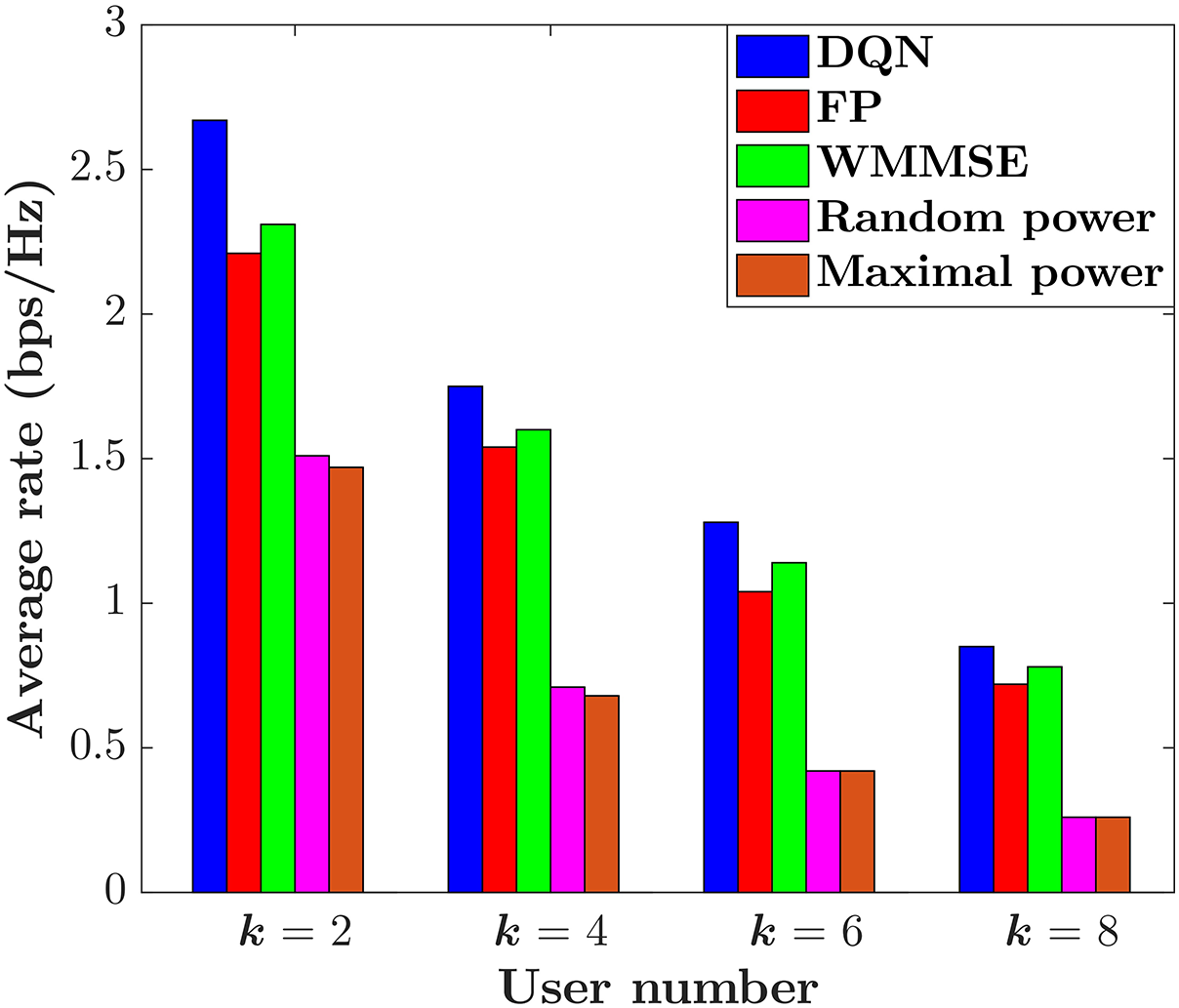
Figure 5: The average rate
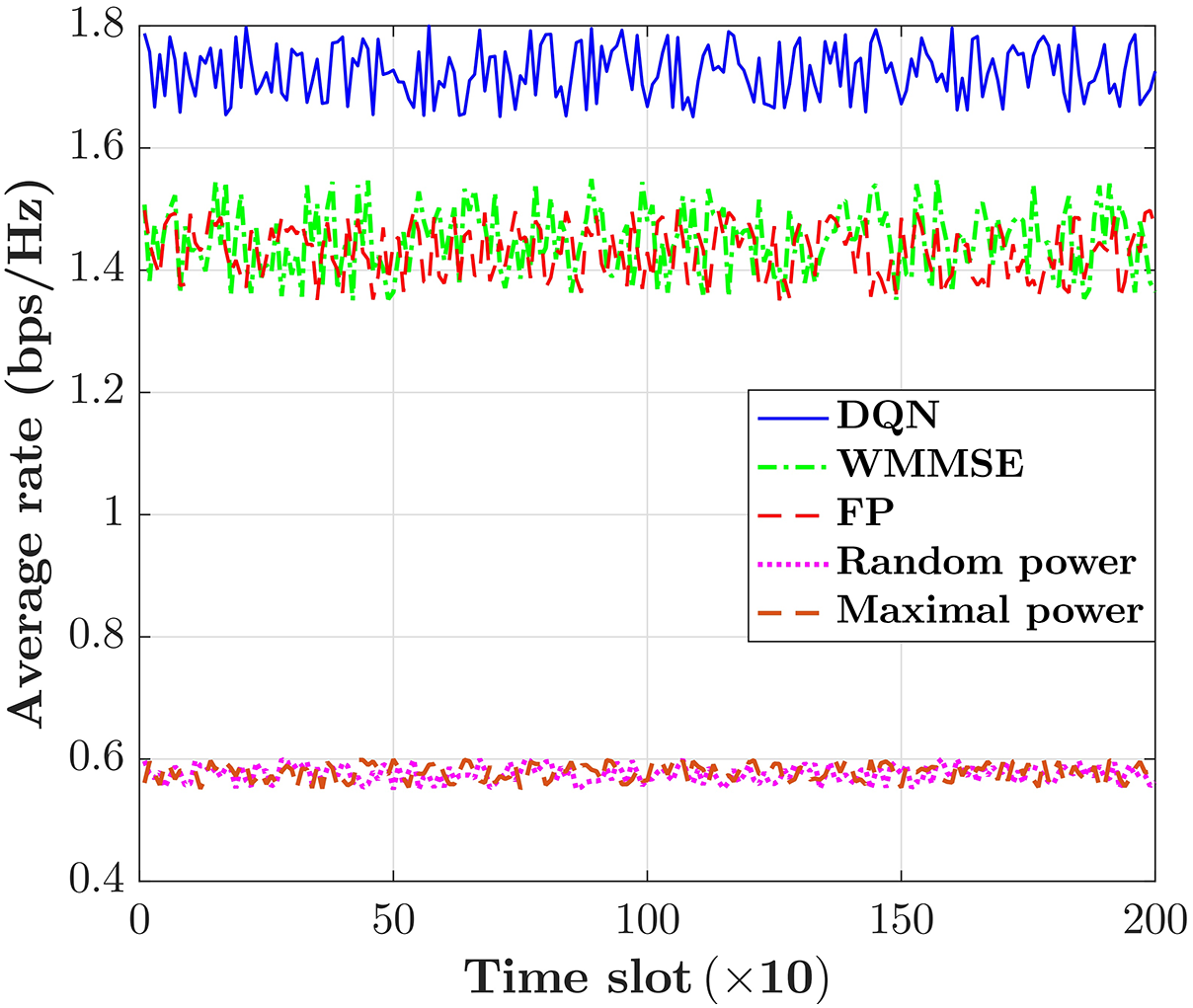
Figure 6: The average rate

Figure 7: The average rate
Table 2 compares the performance of the average rate in terms of frequency


In this paper, we studied the PA problem for wireless multiple-access communication, exploiting the data-driven model-free DQL. In this scenario, we employed the current sumrate as the reward function to align with the power allocation optimization objective. In our proposed DQL algorithm, we elegantly used is as an estimator for the prediction of the current sumrate under all power levels with a specific CSI. The simulation results showed that the trained DQN with zero discount factor provides the highest value of the average sumrate. In addition, it was shown that the proposed DQN has a better performance compared with benchmarks algorithms in terms of the average sumrate, which indicates the designed DQN has proper generalization capabilities. We also introduced offline centralized learning using simulated wireless multi-user communication networks, wherein the acquired knowledge from the trained DQN is assessed through distributed executions. In future research, we plan to explore online learning to align with real-world scenarios involving particular user distributions and propagation environments.
Acknowledgement: The work described in this paper has been developed within the project PRESECREL. We would like to acknowledge the financial support of the Ministerio de Ciencia e Investigación (Spain), in relation to the Plan Estatal de Investigación Científica y Técnica y de Innovación 2017–2020.
Funding Statement: The authors received no specific funding for this study.
Author Contributions: The authors confirm contribution to the paper as follows: Study conception and design: S. Soltani, E. Ghafourian, R. Salehi; data collection: S. Soltani, D. Martín, M. Vahidi; analysis and interpretation of results: E. Ghafourian, R. Salehi, D. Martín, M. Vahidi; draft manuscript preparation: S. Soltani, E. Ghafourian, R. Salehi, D. Martín. All authors reviewed the results and approved the final version of the manuscript.
Availability of Data and Materials: The datasets generated during and/or analyzed during the current study are available from the corresponding author on reasonable request.
Conflicts of Interest: The authors declare that they have no conflicts of interest to report regarding the present study.
References
1. K. David and H. Berndt, “6G vision and requirements: Is there any need for beyond 5G?” IEEE Veh. Technol. Mag., vol. 13, no. 3, pp. 72–80, 2018. [Google Scholar]
2. M. Z. Chowdhury, M. Shahjalal, S. Ahmed, and Y. M. Jang, “6G wireless communication systems: Applications, requirements, technologies, challenges, and research directions,” IEEE Open J. Commun. Soc., vol. 1, pp. 957–975, 2020. [Google Scholar]
3. S. Miri, M. Kaveh, H. S. Shahhoseini, M. R. Mosavi, and S. Aghapour, “On the security of ‘an ultra-lightweight and secure scheme for communications of smart metres and neighbourhood gateways by utilisation of an ARM Cortex-M microcontroller’,” IET Inform. Secur., vol. 13, no. 3, pp. 544–551, 2023. [Google Scholar]
4. I. F. Akyildiz, A. Kak, and S. Nie, “6G and beyond: The future of wireless communications systems,” IEEE Access, vol. 8, pp. 133995–134030, 2020. [Google Scholar]
5. T. O’shea and J. Hoydis, “An introduction to deep learning for the physical layer,” IEEE Trans. Cogn. Commun. Netw., vol. 3, no. 4, pp. 563–575, 2017. [Google Scholar]
6. M. B. Shahab, M. F. Kader, and S. Y. Shin, “On the power allocation of non-orthogonal multiple access for 5G wireless networks,” in 2016 Int. Conf. on Open Source Systems & Technologies (ICOSST), Lahore, Pakistan, 2016, pp. 89–94. [Google Scholar]
7. M. Kaveh, M. S. Mesgari, and B. Saeidian, “Orchard algorithm (OAA new meta-heuristic algorithm for solving discrete and continuous optimization problems,” Math. Comput. Simulat., vol. 208, pp. 95–135, 2023. [Google Scholar]
8. P. Afrasyabi, M. S. Mesgari, M. Razban, and M. Kaveh, “Multi-modal routing using NSGA-II algorithm considering COVID-19 protocols: A case study in Tehran,” Earth Observ. Geomat. Eng., vol. 6, no. 1, pp. 1–14, 2022. [Google Scholar]
9. M. Kaveh, M. S. Mesgari, D. Martín, and M. Kaveh, “TDMBBO: A novel three-dimensional migration model of biogeography-based optimization (case study: Facility planning and benchmark problems),” J. Supercomput., vol. 2023, pp. 1–56, 2023. [Google Scholar]
10. M. Kaveh and M. S. Mesgari, “Hospital site selection using hybrid PSO algorithm-case study: District 2 of Tehran,” Scienti.-Res. Quart. Geo. Data (SEPEHR), vol. 28, no. 111, pp. 7–22, 2019. [Google Scholar]
11. C. Li, Q. Zhang, Q. Li, and J. Qin, “Price-based power allocation for non-orthogonal multiple access systems,” IEEE Wirel. Commun. Le., vol. 5, no. 6, pp. 664–667, 2016. [Google Scholar]
12. J. Zhu, J. Wang, Y. Huang, S. He, X. You and L. Yang, “On optimal power allocation for downlink non-orthogonal multiple access systems,” IEEE J. Sel. Area. Comm., vol. 35, no. 12, pp. 2744–2757, 2017. [Google Scholar]
13. Z. Xiao, L. Zhu, J. Choi, P. Xia, and X. G. Xia, “Joint power allocation and beamforming for non-orthogonal multiple access (NOMA) in 5G millimeter wave communications,” IEEE T. Wirel. Commun., vol. 17, no. 5, pp. 2961–2974, 2018. [Google Scholar]
14. W. U. Khan, F. Jameel, T. Ristaniemi, B. M. Elhalawany, and J. Liu, “Efficient power allocation for multi-cell uplink noma network,” in 2019 IEEE 89th Veh. Technol. Conf. (VTC2019-Spring), Kuala Lumpur, Malaysia, 2019, pp. 1–5. [Google Scholar]
15. N. Najafi, M. Kaveh, D. Martín, and M. R. Mosavi, “Deep PUF: A highly reliable DRAM PUF-based authentication for IoT networks using deep convolutional neural networks,” Sens., vol. 21, no. 9, pp. 2009, 2021. [Google Scholar]
16. S. S. Fard, M. Kaveh, M. R. Mosavi, and S. B. Ko, “An efficient modeling attack for breaking the security of XOR-arbiter PUFs by using the fully connected and long-short term memory,” Microprocess. Microsy., vol. 94, pp. 104667, 2022. [Google Scholar]
17. M. Kaveh, M. S. Mesgari, and A. Khosravi, “Solving the local positioning problem using a four-layer artificial neural network,” Eng. J. Geospatial Inf. Tech., vol. 7, no. 4, pp. 21–40, 2020. [Google Scholar]
18. K. Shen and W. Yu, “Fractional programming for communication systems—Part I: Power control and beamforming,” IEEE T. Signal Proces., vol. 66, no. 10, pp. 2616–2630, 2018. [Google Scholar]
19. Q. Shi, M. Razaviyayn, Z. Q. Luo, and C. He, “An iteratively weighted MMSE approach to distributed sum-utility maximization for a MIMO interfering broadcast channel,” IEEE T. Signal Proces., vol. 59, no. 9, pp. 4331–4340, 2011. [Google Scholar]
20. M. Kaveh, Z. Yan, and R. Jäntti, “Secrecy performance analysis of RIS-aided smart grid communications,” IEEE T. Ind. Inform., 2023. doi: 10.1109/TII.2023.3333842. [Google Scholar] [CrossRef]
21. H. Zhang, L. Venturino, N. Prasad, P. Li, S. Rangarajan and X. Wang, “Weighted sum-rate maximization in multi-cell networks via coordinated scheduling and discrete power control,” IEEE J. Sel. Area Comm., vol. 29, no. 6, pp. 1214–1224, 2011. [Google Scholar]
22. Z. Qin, H. Ye, G. Y. Li, and B. H. F. Juang, “Deep learning in physical layer communications,” IEEE Wirel. Commun., vol. 26, no. 2, pp. 93–99, 2019. [Google Scholar]
23. Y. LeCun, Y. Bengio, and G. Hinton, “Deep learning,” Nature, vol. 521, no. 7553, pp. 436–444, 2015. [Google Scholar] [PubMed]
24. S. Aghapour, M. Kaveh, M. R. Mosavi, and D. Martín, “An ultra-lightweight mutual authentication scheme for smart grid two-way communications,” IEEE Access, vol. 9, pp. 74562–74573, 2021. [Google Scholar]
25. H. Sun, X. Chen, Q. Shi, M. Hong, X. Fu and N. D. Sidiropoulos, “Learning to optimize: Training deep neural networks for interference management,” IEEE T. Signal Proces., vol. 66, no. 20, pp. 5438–5453, 2018. [Google Scholar]
26. F. Meng, P. Chen, L. Wu, and X. Wang, “Automatic modulation classification: A deep learning enabled approach,” IEEE T. Veh. Technol., vol. 67, no. 11, pp. 10 760–10 772, 2018. [Google Scholar]
27. H. Ye, G. Y. Li, and B. H. Juang, “Power of deep learning for channel estimation and signal detection in OFDM systems,” IEEE Wirel. Commun. Le., vol. 7, no. 1, pp. 114–117, 2017. [Google Scholar]
28. R. Amiri, H. Mehrpouyan, L. Fridman, R. K. Mallik, A. Nallanathan and D. Matolak, “A machine learning approach for power allocation in HetNets considering QoS,” in 2018 IEEE Int. Conf. on Communications (ICC), Kansas City, MO, USA, 2018, pp. 1–7. [Google Scholar]
29. H. Rabiei, M. Kaveh, M. R. Mosavi, and D. Martín, “MCRO-PUF: A novel modified crossover RO-PUF with an ultra-expanded CRP space,” Comp. Mater. Contin., vol. 74, no. 3, pp. 4831–4845, 2023. [Google Scholar]
30. F. D. Calabrese, L. Wang, E. Ghadimi, G. Peters, L. Hanzo and P. Soldati, “Learning radio resource management in RANs: Framework, opportunities, and challenges,” IEEE Commun. Mag., vol. 56, no. 9, pp. 138–145, 2018. [Google Scholar]
31. M. Kaveh, S. Aghapour, D. Martín, and M. R. Mosavi, “A secure lightweight signcryption scheme for smart grid communications using reliable physically unclonable function,” in 2020 IEEE Int. Conf. on Environ. and Electr. Eng. and 2020 IEEE Ind. and Commer. Power Syst. Eur. (EEEIC/I&CPS Europe), Madrid, Spain, 2020, pp. 1–6. [Google Scholar]
32. Y. S. Nasir and D. Guo, “Deep reinforcement learning for distributed dynamic power allocation in wireless networks,” arXiv preprint arXiv:1808.00490, 2018. [Google Scholar]
33. Y. Cheng, K. H. Li, Y. Liu, K. C. Teh, and H. V. Poor, “Downlink and uplink intelligent reflecting surface aided networks: NOMA and OMA,” IEEE T. Wirel. Commun., vol. 20, no. 6, pp. 3988–4000, 2021. [Google Scholar]
34. B. Zheng, Q. Wu, and R. Zhang, “Intelligent reflecting surface assisted multiple access with user pairing: NOMA or OMA?” IEEE Commun. Lett., vol. 24, no. 4, pp. 753–757, 2020. [Google Scholar]
35. F. R. Ghadi, G. A. Hodtani, and F. J. Lopez-Martinez, “The role of correlation in the doubly dirty fading MAC with side information at the transmitters,” IEEE Wirel. Commun. Lett., vol. 10, no. 9, pp. 2070–2074, 2021. [Google Scholar]
36. J. Ghosh, V. Sharma, H. Haci, S. Singh, and I. H. Ra, “Performance investigation of NOMA versus OMA techniques for mmWave massive MIMO communications,” IEEE Access, vol. 9, pp. 125300–125308, 2021. [Google Scholar]
37. C. Wu, X. Mu, Y. Liu, X. Gu, and X. Wang, “Resource allocation in STAR-RIS-aided networks: OMA and NOMA,” IEEE T. Wirel. Commun., vol. 21, no. 9, pp. 7653–7667, 2022. [Google Scholar]
38. F. R. Ghadi and F. J. Lopez-Martinez, “RIS-aided communications over dirty MAC: Capacity region and outage probability,” arXiv preprint arXiv:2208.07026, 2022. [Google Scholar]
39. F. R. Ghadi and W. P. Zhu, “Performance analysis over correlated/independent Fisher-Snedecor F fading multiple access channels,” IEEE T. Veh. Technol., vol. 71, no. 7, pp. 7561–7571, 2022. [Google Scholar]
40. Q. Wang, H. Chen, C. Zhao, Y. Li, P. Popovski and B. Vucetic, “Optimizing information freshness via multiuser scheduling with adaptive NOMA/OMA,” IEEE T. Wirel. Commun., vol. 21, no. 3, pp. 1766–1778, 2021. [Google Scholar]
41. X. Mu, Y. Liu, L. Guo, J. Lin, and Z. Ding, “Energy-constrained UAV data collection systems: NOMA and OMA,” IEEE T. Veh. Technol., vol. 70, no. 7, pp. 6898–6912, 2021. [Google Scholar]
42. F. R. Ghadi and G. A. Hodtani, “Copula function-based analysis of outage probability and coverage region for wireless multiple access communications with correlated fading channels,” IET Commun., vol. 14, no. 11, pp. 1804–1810, 2020. [Google Scholar]
43. L. Sanguinetti, A. Zappone, and M. Debbah, “Deep learning power allocation in massive MIMO,” in 2018 52nd Asilomar Conf. on Signals, Systems, and Computers, Pacific Grove, USA, IEEE, 2018, pp. 1257–1261. [Google Scholar]
44. S. Wang, Y. C. Wu, M. Xia, R. Wang, and H. V. Poor, “Machine intelligence at the edge with learning centric power allocation,” IEEE T. Wirel. Commun., vol. 19, no. 11, pp. 7293–7308, 2020. [Google Scholar]
45. Y. S. Nasir and D. Guo, “Multi-agent deep reinforcement learning for dynamic power allocation in wireless networks,” IEEE J. Sel. Area Comm., vol. 37, no. 10, pp. 2239–2250, 2019. [Google Scholar]
46. H. Saad, A. Mohamed, and T. ElBatt, “Distributed cooperative Q-learning for power allocation in cognitive femtocell networks,” in 2012 IEEE Vehicular Technology Conf. (VTC Fall), Quebec City, QC, Canada, 2012, pp. 1–5. [Google Scholar]
47. R. Amiri, H. Mehrpouyan, L. Fridman, R. K. Mallik, A. Nallanathan and D. Matolak, “Matolak A machine learning approach for power allocation in HetNets considering QoS,” in 2018 IEEE Int. Conf. on Communications (ICC), Pacific Grove, CA, USA, 2018, pp. 1–7. [Google Scholar]
48. G. Sun, D. Ayepah-Mensah, R. Xu, V. K. Agbesi, G. Liu and W. Jiang, “Transfer learning for autonomous cell activation based on relational reinforcement learning with adaptive reward,” IEEE Syst. J., vol. 16, no. 1, pp. 1044–1055, Mar. 2022. [Google Scholar]
49. H. Li, H. Gao, T. Lv, and Y. Lu, “Deep Q-learning based dynamic resource allocation for self-powered ultra-dense networks,” in 2018 IEEE Int. Conf. on Communications Workshops (ICC Workshops), Kansas City, MO, USA, 2018, pp. 1–6. [Google Scholar]
50. Z. Xu, Y. Wang, J. Tang, J. Wang, and M. C. Gursoy, “A deep reinforcement learning based framework for power-efficient resource allocation in cloud RANs,” in 2017 IEEE Int. Conf. on Communications (ICC), Paris, France, 2017, pp. 1–6. [Google Scholar]
51. J. Liu, B. Krishnamachari, S. Zhou, and Z. Niu, “DeepNap: Data-driven base station sleeping operations through deep reinforcement learning,” IEEE Inter. Things J., vol. 5, no. 6, pp. 4273–4282, Dec. 2018. [Google Scholar]
52. A. El Gamal and Y. H. Kim, Network Information Theory. Cambridge, UK: Cambridge University Press, 2011. [Google Scholar]
53. F. R. Ghadi, M. Kaveh, and D. Martín, “Performance analysis of RIS/STAR-IOS-aided V2V NOMA/OMA communications over composite fading channels,” IEEE Transactions on Intelligent Vehicles, 2023. doi: 10.1109/TIV.2023.3337898. [Google Scholar] [CrossRef]
54. R. S. Sutton and A. G. Barto, Reinforcement Learning: An Introduction. vol. 22447. Cambridge, MA: MIT Press, 1998. [Google Scholar]
55. D. P. Kingma and J. Ba, “Adam: A method for stochastic optimization,” arXiv preprint arXiv:1412.6980. 2014. [Google Scholar]
Cite This Article
 Copyright © 2024 The Author(s). Published by Tech Science Press.
Copyright © 2024 The Author(s). Published by Tech Science Press.This work is licensed under a Creative Commons Attribution 4.0 International License , which permits unrestricted use, distribution, and reproduction in any medium, provided the original work is properly cited.


 Submit a Paper
Submit a Paper Propose a Special lssue
Propose a Special lssue View Full Text
View Full Text Download PDF
Download PDF Downloads
Downloads
 Citation Tools
Citation Tools